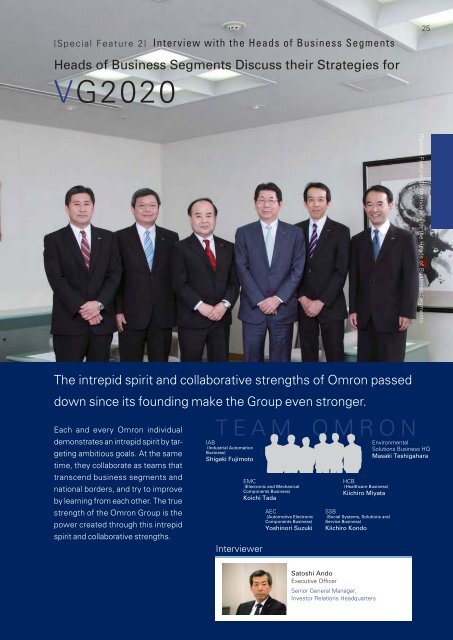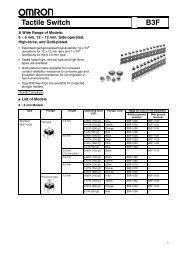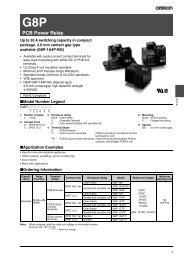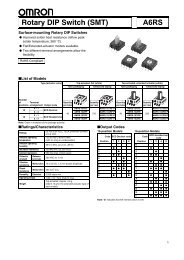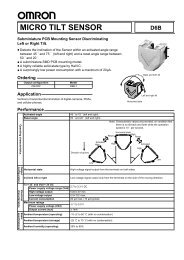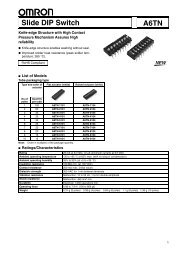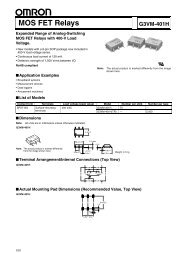VG2020 - Omron
VG2020 - Omron
VG2020 - Omron
Create successful ePaper yourself
Turn your PDF publications into a flip-book with our unique Google optimized e-Paper software.
[Special Feature 2] Interview with the Heads of Business Segments<br />
25<br />
Heads of Business Segments Discuss their Strategies for<br />
<strong>VG2020</strong><br />
[Special Feature 2] Interview with the Heads of Business Segments<br />
The intrepid spirit and collaborative strengths of <strong>Omron</strong> passed<br />
down since its founding make the Group even stronger.<br />
Each and every <strong>Omron</strong> individual<br />
demonstrates an intrepid spirit by targeting<br />
ambitious goals. At the same<br />
time, they collaborate as teams that<br />
transcend business segments and<br />
national borders, and try to improve<br />
by learning from each other. The true<br />
strength of the <strong>Omron</strong> Group is the<br />
power created through this intrepid<br />
spirit and collaborative strengths.<br />
TEAM OMRON<br />
IAB<br />
(Industrial Automation<br />
Business)<br />
Shigeki Fujimoto<br />
Interviewer<br />
EMC<br />
(Electronic and Mechanical<br />
Components Business)<br />
Koichi Tada<br />
AEC<br />
(Automotive Electronic<br />
Components Business)<br />
Yoshinori Suzuki<br />
HCB<br />
(Healthcare Business)<br />
Kiichiro Miyata<br />
SSB<br />
(Social Systems, Solutions and<br />
Service Business)<br />
Kiichiro Kondo<br />
Environmental<br />
Solutions Business HQ<br />
Masaki Teshigahara<br />
Satoshi Ando<br />
Executive Officer<br />
Senior General Manager,<br />
Investor Relations Headquarters
26<br />
[Special Feature 2] Interview with the Heads of Business Segments<br />
Ando: The three tasks set out in the “GLOBE STAGE” (FY2011–2014) of <strong>Omron</strong>’s “Value Generation 2020”<br />
are (1) Reinforcement of the Industrial Automation (IA) Business, (2) Sales expansion in emerging markets,<br />
and (3) Focus on the environmental solutions business. I interviewed the heads of <strong>Omron</strong>’s six main business<br />
segments about how “Team <strong>Omron</strong>” should demonstrate its collaborative strengths.<br />
Reinforcement of Industrial<br />
Automation (IA) Business<br />
Ando: In line with the view that manufacturing markets<br />
will continue expanding centered on emerging<br />
economies, one of the priorities of “Value Generation<br />
2020” is to maximize <strong>Omron</strong>’s industrial automation<br />
business, which is driven by two companies: the<br />
Industrial Automation Business (IAB) and the<br />
Electronic and Mechanical Components Business<br />
(EMC). First, I would like to hear the views of the presidents<br />
of IAB and EMC.<br />
Striving to be the Number One in<br />
“Control,” “Product Lineup,” and<br />
the “Future.”<br />
——— Please explain the basic strategy of the IAB,<br />
the core business segment of the <strong>Omron</strong> Group.<br />
Fujimoto (IAB): Our basic strategy is to become number<br />
one in “control,” “product lineup,” and the<br />
“future.” It is highly risky to focus merely on making<br />
machines work faster and more accurately at production<br />
sites. If we add the element of safety, we can<br />
become the number one in “control” by being the best<br />
in high-speed, high-precision, and safe machine control.<br />
Being the number one in “product lineup” means<br />
having the broadest offerings. And then there is being<br />
the number one in the “future.” In Japan’s case, the<br />
manufacturing industry accounts for 40% of total electric<br />
power consumption. Being the number one in the<br />
“future” means becoming the top player by offering<br />
new value through a focus on controlling the energy<br />
used by machines in an automated factory setting.<br />
We at <strong>Omron</strong> will strive to achieve these goals<br />
IAB<br />
Current position: Managing Officer<br />
President, Industrial Automation Company<br />
Date of birth: February 19, 1958 (age 53)<br />
Words to live by: Stay abreast of changing times, but don’t lose sight<br />
of your beliefs<br />
SHIGEKI<br />
FUJIMOTO<br />
in the global market. This will necessitate more<br />
crossover between the vertical (business companies)<br />
and horizontal (head office and administrative<br />
divisions) not only within IAB, but also across the<br />
entire <strong>Omron</strong> Group. I believe that it is also important<br />
to foster global human resources who will be<br />
positioned at these crossover points.<br />
Places without Fixed-Line Phones<br />
Suddenly Filled with Smartphones<br />
IA Business (IAB & EMC) Reinforcement<br />
353.1<br />
FY2010<br />
Emerging<br />
Markets<br />
+80<br />
Developed<br />
Countries<br />
+20<br />
Sales up<br />
¥100 bn<br />
(Billions of yen)<br />
450<br />
IA<br />
Business<br />
Sales (IAB<br />
& EMC)<br />
FY2013<br />
est.<br />
——— What or where are the sources of demand<br />
for the products of the Industrial Automation<br />
Business?<br />
Fujimoto (IAB): Our business supplies emerging markets,<br />
primarily China. Now, 80% of our clients in China<br />
are local manufacturers, and recently, I have sensed a<br />
surge in demand for automation. But what they seek<br />
varies greatly. One feature of emerging markets, including<br />
China, is “discontinuous evolution.” One example<br />
of this is the building of a network for smartphones in<br />
a place that didn’t even have infrastructure for fixedline<br />
phones. In other words, there are two types of<br />
demand at the same time. On the one hand, there is
KOICHI<br />
TADA<br />
EMC<br />
Current position: Executive Officer<br />
President, Electronic and Mechanical Components Company<br />
Date of birth: January 27, 1954 (age 57)<br />
Words to live by: Fall seven times, stand up eight<br />
the need for basic automation that is compatible with<br />
the standards of a particular area. On the other hand,<br />
there is demand for sophisticated functions that would<br />
not be out of place in an advanced market.<br />
Adopting the Same Approach will Fail<br />
in the Face of Local Competition<br />
——— What kind of strategies do you adopt in<br />
emerging markets, where competition is intense?<br />
Fujimoto (IAB): Broadly speaking, there are two types<br />
of competition: “global competition” and “local competition.”<br />
As an outsider, the odds are against us if we<br />
pursue the same strategy as local competitors.<br />
Therefore, we must differentiate our products by leveraging<br />
the advantages that our global supply chain gives<br />
us, or by possessing the best product lineup, which<br />
allows us to meet the needs of advanced markets.<br />
Against global competition, however, having some kind<br />
of innovative element will give us the upper hand. This<br />
is why we strive to become the number one in highspeed,<br />
high-precision, and safe machine control.<br />
Naturally, it is also important to enhance profitability.<br />
This can be achieved in three ways: inexpensive<br />
production, keeping expenses down, and getting the<br />
purchaser to pay a high price in recognition of a product’s<br />
value. Regarding inexpensive production and a<br />
high purchase price, we have adopted a new approach<br />
that completely overturns traditional manufacturing<br />
principles based on Japanese standards. Specifically,<br />
we first build a common platform based on a global<br />
standard, which we then customize. In emerging markets,<br />
we must also provide products that can compete<br />
with the low-cost products available locally, while maintaining<br />
our usual high quality. In this case, we add our<br />
technology to inexpensive locally procured compo-<br />
nents. By then raising quality through improved durability,<br />
for example, we can deliver products that best<br />
suit the standards in that area.<br />
As for enhancing added value, we recently established<br />
an Automation Center in China. The Center is able<br />
to test the connectivity of products, including those<br />
made by other manufacturers. By also increasing what<br />
we offer to include both quality and services, we are pursuing<br />
a strategy aimed at raising total added value.<br />
Because speed is of the essence in emerging markets,<br />
we intend to establish the infrastructure needed<br />
for this sort of competitive strategy within the threeyear<br />
“GLOBE STAGE” (FY2011–2014) of “Value<br />
Generation 2020.”<br />
——— From the perspective of maintaining a<br />
competitive advantage, how will you advance<br />
collaboration between IAB and EMC?<br />
Tada (EMC): In the second half of last year, we established<br />
an Industrial Components Discussion Group,<br />
which will focus on the industrial automation market<br />
and capturing demand from emerging markets. The<br />
aim is to deepen the mutual understanding that exists<br />
between my company and IAB concerning strategies,<br />
and to work together while we find common ground.<br />
Thanks to our mutual understanding, we have already<br />
decided to invest strategically in increasing production<br />
of relays for the IA market. Given that EMC’s mission<br />
is to supply relays and switches used in core products<br />
across the entire Group, I would like to see our operations<br />
underscored by a strong commitment to<br />
“coexistence.”<br />
Strengthening Relationships with<br />
Horizontal Functions Key to<br />
Reinforcing “Monozukuri Capabilities”<br />
——— How will EMC strengthen IA business from<br />
the perspective of “monozukuri capabilities?”<br />
Tada (EMC): In order to capture demand from emerging<br />
markets, it is essential that, in addition to reinforcing<br />
supply capabilities, we also improve productivity by<br />
developing materials, developing techniques, and making<br />
advances in automation. EMC is limited in what it<br />
can do on its own when it comes to monozukuri capabilities.<br />
Therefore, I would like each business company<br />
to work together as Team <strong>Omron</strong> to hone those capabilities.<br />
This will enable us to provide products with<br />
exceptional QCDS (quality, cost, delivery, and service),<br />
where <strong>Omron</strong>’s strengths lie, while strengthening<br />
collaboration with the head office functions of the Global<br />
Process Innovation Headquarters and the Research<br />
& Development Headquarters.<br />
27<br />
[Special Feature 2] Interview with the Heads of Business Segments
28<br />
Sales Expansion in Emerging Markets<br />
[Special Feature 2] Interview with the Heads of Business Segments<br />
Ando: Achieving growth during the “GLOBE<br />
STAGE” depends on capturing demand from<br />
emerging markets. I would like to ask the presidents<br />
of IAB, EMC, AEC, and HCB—all of which operate<br />
on a global basis, about this topic.<br />
Nothing Beats Frontline Power<br />
——— How will IAB capture demand from emerging<br />
markets?<br />
Fujimoto (IAB): Contact with customers is most<br />
important. For this reason, in the next three years we<br />
plan to double our frontline staff in emerging markets,<br />
which will double the speed at which we can identify<br />
customers’ problems. In China, the largest emerging<br />
market, we will increase the number of sales and marketing<br />
sites by 20 in the year ending March 2012, to a<br />
total of 52. We will achieve this in just one year, not<br />
three. In the next three years, we will also make a sixfold<br />
increase in the number of engineers offering<br />
technical support.<br />
Establishment of an Automation Center in Shanghai China<br />
Three-Year “GLOBE STAGE” Calls<br />
for Strengthening Production and<br />
Supply Capabilities<br />
——— What kind of strategy does EMC have in mind<br />
for consumer electronic components?<br />
Tada (EMC): In China, with a population of 1.3 billion,<br />
and India with 1.1 billion, the number of people in the<br />
middle-income group is rising annually. Accordingly,<br />
we imagine that the quality standard sought in emerging<br />
markets for commercial and consumer electronic<br />
components will become the same as that sought by<br />
middle-income earners in developed countries. Also,<br />
given that there are markets where “discontinuous<br />
evolution” occurs, as Mr. Fujimoto has said, we need<br />
to adopt a global perspective regarding strengthening<br />
supply capabilities and raising productivity. Of course,<br />
it is crucial that we waste no time in establishing what<br />
global standards are and what kind of specifications<br />
and applications are needed. Accordingly, we will also<br />
reinforce marketing activities to gather information.<br />
As for raising productivity, we will build a competitive<br />
advantage by reducing the materials we use and<br />
utilizing automation to lower manufacturing costs. In<br />
addition, because speed makes or breaks opportunities<br />
in an emerging market, we will strengthen our<br />
production and supply capabilities over the three-year<br />
period of the “GLOBE STAGE.”<br />
——— What points will the Automotive Electronic<br />
Components Business focus on during the<br />
“GLOBE STAGE” with respect to emerging markets<br />
in particular?<br />
Suzuki (AEC): We have a fairly good idea of our business<br />
volumes through the fiscal year ending March<br />
2014. This is because we are actively advancing production<br />
plans for clients from whom we have already<br />
received orders. They come from a variety of businesses<br />
and are part of a network that has car manufacturers at<br />
the apex. During the “GLOBE STAGE,” we will seek to<br />
establish an earnings structure that has an operating<br />
margin higher than the industry standard (5–6%). We<br />
will also focus on sowing seeds for growth in the next<br />
stage. Another strategy we are actively pursuing is to<br />
foster global human resources within an integrated production,<br />
sales, and development structure.<br />
One year since the spin-off of AEC and the transfer<br />
of all employees to the new company, we are fully prepared<br />
for our advance into a new stage. We will target<br />
growth while emphasizing our enduring advantages,<br />
which are the capabilities of employees and the<br />
strengths of Team <strong>Omron</strong>. Since we have finally<br />
achieved a return to profitability, we intend to invest<br />
around half of the company’s profits in growth areas.<br />
Sales Expansion in Emerging Markets<br />
approx. 160<br />
FY2010<br />
IA Business<br />
(IAB & EMC)<br />
+80<br />
HCB,<br />
Other<br />
+30<br />
Sales up<br />
¥110 bn<br />
(Billions of yen)<br />
approx. 270<br />
Sales in<br />
Emerging<br />
Markets*<br />
FY2013<br />
* Emerging markets: Greater China, Southeast Asia (plus India), Latin America (Brazil, etc.), Eastern Europe,<br />
Russia, the Middle East, and South Africa<br />
est.
YOSHINORI<br />
SUZUKI<br />
AEC<br />
Current position: Managing Officer<br />
CEO & President, <strong>Omron</strong> Automotive Electronics Co., Ltd.<br />
Date of birth: April 27, 1952 (age 59)<br />
Words to live by: Benevolence, justice, courtesy, wisdom<br />
——— What is AEC’s approach to emerging markets?<br />
Suzuki (AEC): The standard practice among the world’s<br />
leading automakers is to develop local models based<br />
on a standardized global platform. However, we are<br />
beginning to see a gradual shift toward building a separate<br />
platform for each area. You heard from Mr. Tada,<br />
president of EMC, of the increasing uniformity in quality<br />
standards for commercial and consumer electronic<br />
components. For finished vehicles, however, the opposite<br />
applies, as there is a growing trend toward<br />
customizing specifications, price, and design to meet<br />
the needs of a particular area.<br />
Evolution of China’s Automobile<br />
Industry Unlike Other Emerging<br />
Markets<br />
——— What kind of strategies does AEC have in<br />
mind for the Chinese market?<br />
Suzuki (AEC): Amid this move toward customization,<br />
we need to approach China differently from other<br />
emerging markets in Asia. With the exception of China,<br />
there will be no significant changes in the industry’s<br />
main players. In China, many local manufacturers are<br />
becoming stronger, attributable in part to the government’s<br />
policy of providing assistance. On the demand<br />
side too, medium, large, and luxury cars are becoming<br />
increasingly popular in China, unlike in other emerging<br />
markets, which are about to enter a growth phase. This<br />
is why we are pursuing a policy of turning our production<br />
sites in China into autonomous bases that combine<br />
all stages, from development to production and sales.<br />
Even though local manufacturers are becoming bigger,<br />
they lack the know-how that enables cutting-edge<br />
global manufacturers to keep a firm grip on thousands,<br />
even tens of thousands, of parts, which they put together<br />
to make high-quality components. Conversely, this<br />
presents a business opportunity. Accordingly, we are<br />
cooperating with a variety of parts suppliers with a view<br />
to providing our local business partners in China with<br />
products that are easier to assemble. In addition to our<br />
electronic control units, these include seat belts,<br />
motors, and batteries.<br />
——— What is the basic strategy of the Healthcare<br />
Business for business expansion targeting consumers?<br />
Miyata (HCB): Under “Value Generation 2020,” our<br />
vision is to make testing and health management more<br />
familiar to the average consumer. The basic strategy<br />
of HCB comprises three courses of action to improve<br />
such familiarity.<br />
The first is to improve customer accessibility. This<br />
entails increasing customer sales channels, in other<br />
words, broadening sales so that <strong>Omron</strong> products are<br />
available for purchase around the world. The second<br />
is to improve the accessibility of equipment. HCB has<br />
created a market by offering home-use products that<br />
perform testing and measurement functions—such<br />
as taking blood pressure readings—that are normally<br />
carried out at medical facilities. Our aim is to contribute<br />
to the early detection and treatment of ailments by<br />
accelerating the development of safe, reasonably priced<br />
equipment that is easy to operate. This will lead to<br />
improved accessibility to testing, as it shifts from medical<br />
settings to the home and from large hospitals to<br />
local clinics. The third course of action is to improve<br />
the accessibility of data services. This involves making<br />
healthcare and medical services more accessible<br />
by means of information services that store and analyze<br />
readings.<br />
Aggressive Efforts to Broaden<br />
Sales Coverage<br />
——— What are HCB’s projections for emerging<br />
markets, and what growth strategy is it pursuing?<br />
Miyata (HCB): In the case of home medical equipment,<br />
the rule of thumb is that demand rises suddenly<br />
once GDP per capita exceeds $10,000. We have seen<br />
this happen in China, followed by Russia. Since the<br />
GDP per capita in Brazil was over $8,000 in the year<br />
ended March 31, 2010, we can expect to see growth<br />
in the near future. Higher incomes not only lead to<br />
economic development, but in emerging markets,<br />
they also result in expansion of the customer base.<br />
As incomes increase, meanwhile, lifestyles become<br />
more affluent, which is associated with an increase<br />
29<br />
[Special Feature 2] Interview with the Heads of Business Segments
30<br />
[Special Feature 2] Interview with the Heads of Business Segments<br />
in lifestyle-related diseases, such as high blood pressure<br />
and diabetes.<br />
In light of this trend, our growth strategy focuses<br />
on broadening sales coverage. At present, we supply<br />
products to 260,000 large chainstore and drugstore<br />
outlets around the world. Our aim is to increase this<br />
number to 400,000 by the year ending March 2021.<br />
Most of the increase will come from emerging markets.<br />
In China, our products are currently sold in 20,000<br />
stores, and we plan to elevate this to 30,000 stores by<br />
next year. In India too, we will raise the number of<br />
stores handling our products to 10,000 in the current<br />
fiscal year by increasing distributors from a handful to<br />
more than 30.<br />
One initiative to widen coverage is to restrict the<br />
number of categories controlled from Japan to four:<br />
blood pressure monitors, blood glucose monitors, thermometers,<br />
and nebulizers. Meanwhile, we are<br />
implementing a policy that transforms area sales companies<br />
into business companies responsible for<br />
planning in their respective areas. This is because some<br />
areas have major health needs for specific conditions.<br />
One example is chronic obstructive pulmonary disease<br />
(COPD), which is connected to asthma and high smoking<br />
rates. We are considering accelerating the shift from<br />
sales companies to business companies so that in areas<br />
where this disease is prevalent, we can broaden coverage<br />
by getting local companies to engage in planning<br />
and be responsible for selling all of their stock.<br />
Store in Bangalore, India<br />
——— What product strategies have you devised<br />
for emerging markets?<br />
Miyata (HCB): We will seek to deliver products with<br />
cost and quality that surpass local value standards.<br />
Bringing Japanese standards to emerging markets<br />
won’t work. We will target these markets by offering<br />
inexpensive models with simple functions. To capture<br />
the top market share in emerging economies, of<br />
course, we must manufacture products at the lowest<br />
cost in the world. For example, in China, not Japan,<br />
we are developing a ventilator that meets local demand<br />
through an alliance with a local manufacturer.<br />
However, this does not apply to mainstay products.<br />
For these, collaboration with the <strong>Omron</strong> Group’ s horizontal<br />
(head office) divisions in conjunction with the<br />
Global Process Innovation Headquarters will become<br />
increasingly important.<br />
Top Runner of Team <strong>Omron</strong> to Raise<br />
the Profile of the <strong>Omron</strong> Brand<br />
HCB<br />
Current position: Executive Officer<br />
CEO & President, <strong>Omron</strong> Healthcare Co., Ltd.<br />
Date of Birth: July 24, 1960 (age 51)<br />
Words to live by: Innovation as a way of life<br />
KIICHIRO<br />
MIYATA<br />
——— What are HCB’s brand strategies?<br />
Miyata (HCB): In the case of consumer products, the<br />
most effective method is to secure shelf space in retail<br />
outlets and capture a sizable market with a full product<br />
lineup first, and then invest in a broad strategy. You<br />
can’t afford to be too quick or too slow off the mark. In<br />
India, we are approaching the stage in which we should<br />
invest in a brand strategy. First we will enhance recognition<br />
of <strong>Omron</strong> as a medical equipment and healthcare<br />
product manufacturer, then enhance brand recognition<br />
amongst medical practitioners. Then we will roll<br />
out a mass-marketing brand strategy.<br />
More than anything else, the healthcare business<br />
has the important mission of leading Team <strong>Omron</strong>’s<br />
campaign of raising the <strong>Omron</strong> brand profile among<br />
consumers. Under “Value Generation 2020,” we will<br />
strive to spread the <strong>Omron</strong> brand as widely as possible<br />
on a global scale while collaborating closely with<br />
the head office.
Focus on the Environmental<br />
Solutions Business<br />
31<br />
Ando: The third task for growth is to focus on the<br />
environmental solutions business. I would like to<br />
ask the president of SSB and the senior general<br />
manager of the Environmental Solutions Business<br />
HQ about this topic.<br />
Optimum Control of Energy<br />
——— Please tell us about initiatives being undertaken<br />
by the Environmental Solutions Business HQ.<br />
Teshigahara (Environment): The Environmental<br />
Solutions Business HQ focuses on the optimal control<br />
of energy. Its specific objectives are to expand the energy-saving<br />
business by selling packages to the<br />
manufacturing industry, globally advance the energy-creation<br />
business centered on solar power<br />
conditioners, and meet future needs through an integrated<br />
energy solutions business that blends energy<br />
saving and energy creation.<br />
With a three-tier structure, the energy-saving business<br />
consists of (1) a component business for sensing<br />
the energy and the environment in which it is used, (2)<br />
a remote monitoring system business that sends<br />
sensed energy data to customers via application service<br />
providers, and (3) a solutions business that offers<br />
consulting and engineering services based on energy<br />
data and helps businesses reduce energy consumption<br />
and carbon dioxide emissions.<br />
The energy-creation business will enhance its lineup<br />
by adding solar power conditioners and peripheral<br />
equipment for industrial applications to its existing<br />
range of offerings for the home. In addition to global<br />
expansion centered on Europe and China, it will also<br />
develop core products used in energy control as well<br />
as power storage.<br />
The integrated energy solutions business will incorporate<br />
the creation, storage, and wise use of energy<br />
into energy flow control with the primary objective of<br />
developing a mini grid business mainly targeting corporations.<br />
Instead of merely measuring and visualizing<br />
the status of energy usage, in true <strong>Omron</strong> Group style,<br />
the business will provide solutions that “sense”<br />
whether or not the excess energy can be used for economic<br />
activities.<br />
[Special Feature 2] Interview with the Heads of Business Segments<br />
MASAKI<br />
TESHIGAHARA<br />
Integrated Energy Solution<br />
ENVIRON<br />
MENTAL<br />
Current position: Executive Officer<br />
Senior General Manager, Environmental Solutions Business HQ<br />
Date of birth: August 7, 1958 (age 53)<br />
Words to live by: Stake all or nothing<br />
Energy Saving Energy Creation<br />
<br />
Group-wide Efforts to Meet Eco-related Demand<br />
(components, devices, etc.)<br />
FA equipment, relays and more
32<br />
[Special Feature 2] Interview with the Heads of Business Segments<br />
Spread of Dispersed Power Sources<br />
a Golden Opportunity for the Group<br />
——— The environment is an issue shared by all<br />
business divisions. What opportunities exist for<br />
collaboration within Team <strong>Omron</strong>?<br />
Teshigahara (Environment): The Environmental<br />
Solutions Business HQ does not only develop business<br />
on its own. It also actively collaborates in fields<br />
where there is an overlap of domains with other<br />
business companies, with the aim to minimize omissions<br />
and oversights by sharing an understanding of<br />
key issues.<br />
Let me give a specific example. We are collaborating<br />
with IAB in the field of energy and environmental<br />
sensing for industrial machinery. Our first venture focuses<br />
on an electricity sensor that contributes to power<br />
saving. Here, our aim is to augment IAB’s products and<br />
work jointly on activities that deliver new added value<br />
to customers. We are looking to leverage synergies<br />
between AEC’s energy control technology for electric<br />
vehicles and our own energy controllers. Further, we<br />
are pursuing an approach with the Social Systems,<br />
Solutions and Service Business that will further integrate<br />
business development of the environmental<br />
solutions business. Collaborative efforts include utilizing<br />
the data center belonging to software company,<br />
<strong>Omron</strong> Software Co., Ltd., and working with <strong>Omron</strong><br />
Field Engineering Co., Ltd., SSB’s field engineering<br />
company, on solutions for reducing carbon dioxide<br />
emissions.<br />
Furthermore, at a time when dispersed power<br />
sources are the focus of much attention, we are working<br />
with EMC on the marketing of smart energy<br />
equipment, such as smart meters and smart taps.<br />
Because the proliferation of dispersed energy sources<br />
will change energy infrastructure from the ground up,<br />
we view it as an excellent opportunity for Team <strong>Omron</strong>.<br />
In the sense that we are casting a wide net that covers<br />
the full gamut of environmental needs, we definitely<br />
want to contribute as a horizontally aligned entity.<br />
Environment-related Business Sales (<strong>Omron</strong> Sales Total)<br />
approx. 13<br />
FY2010<br />
x 4<br />
(Billions of yen)<br />
approx. 50<br />
FY2013<br />
est.
KIICHIRO<br />
KONDO<br />
SSB<br />
Current position: Managing Officer<br />
CEO & President, <strong>Omron</strong> Social Solutions Co., Ltd.<br />
Date of birth: December 10, 1954 (age 56)<br />
Words to live by: A friend in need is a friend indeed.<br />
Engineering and Software Make a<br />
Valuable Contribution<br />
——— Lastly, I would like to ask about the growth<br />
strategies of SSB.<br />
Kondo (SSB): SSB provides solutions for railways,<br />
roads, and other social infrastructure that support our<br />
earnings base, as well as those that offer safety and<br />
security for commercial facilities. We also view the<br />
environmental solutions business as a new growth<br />
domain. Therefore, in April 2011, the environmental<br />
solutions business department was established within<br />
SSB, deepening collaboration with the Environmental<br />
Solutions Business HQ. With the field engineering company,<br />
<strong>Omron</strong> Field Engineering Co., Ltd., and the<br />
software company, <strong>Omron</strong> Software Co., Ltd., under<br />
our umbrella, we have much to offer Team <strong>Omron</strong> in<br />
the environmental solutions business. At the same time,<br />
we plan to work closely with customers on total solutions<br />
by integrating these two companies into “Team<br />
SSB.”<br />
ities to add new value by using a camera and image<br />
processing sensors to regulate temperature and lighting<br />
while measuring the concentration of people in a<br />
certain location. We are keen to match these capabilities<br />
to social needs. At the same time, we will build a<br />
business that can deliver one-stop services as Team<br />
<strong>Omron</strong>, including maintenance and construction, while<br />
collaborating with the Environmental Solutions<br />
Business HQ.<br />
Ando: I sincerely hope that this discussion will pass<br />
on to shareholders and other investors the enthusiasm<br />
with which the Group’s businesses are<br />
promoting the three main strategies for the “GLOBE<br />
STAGE” of “Value Generation 2020, ” and applying<br />
the collaborative capabilities of Team <strong>Omron</strong>.<br />
33<br />
[Special Feature 2] Interview with the Heads of Business Segments<br />
A Solutions Innovator that Surprises<br />
and Impresses Society<br />
——— Specifically, how will the environmental solutions<br />
business draw on the strengths of SSB?<br />
Kondo (SSB): We are striving to become a solutions<br />
innovator that both surprises and impresses society.<br />
Therefore, we are shifting to a solutions-based business<br />
that does not end with the sale of components.<br />
Let’s take the example of not only being able to visualize<br />
the status of energy usage, but also having optimal<br />
control of energy. We have the technological capabil-


